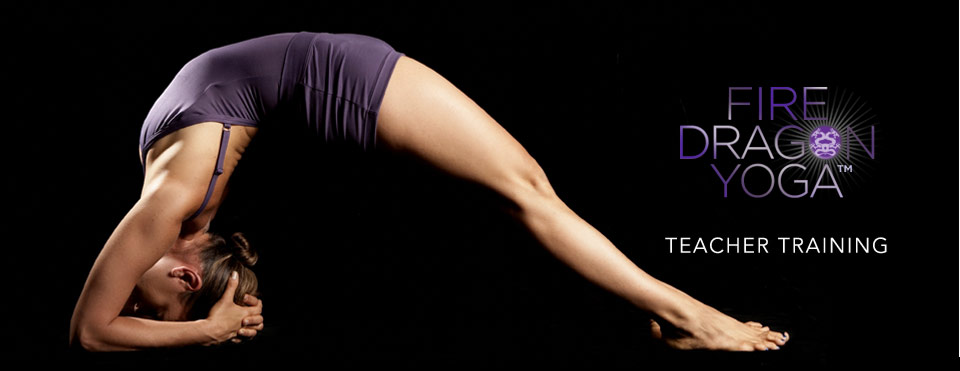
FireDragonYoga™ is where East meets West. In China, when one is born under the Chinese zodiac sign of the Fire Dragon, it is a most celebratory time. Downright electrifying, Fire Dragons breathe vigor and power. Natural leaders, they smile at adversity, turn complainers into optimists, and lead lives that are inspiring and transformative. The practice is the same: vigorous yet calming, strong and supple at the same time — athletic, and healing all at once. The practitioner explores unknown territories in his/her own abilities by getting pushed out his/her comfort zone — in the most compassionate manner. This unique style of yoga involves technical aspects of anatomy and alignment combined with a thoughtful philosophical approach, making the practice fully integrated: mind, body, and spirit.
When you take a FireDragonYoga™ class, you end up doing things with your body that you never thought possible. As the body opens and expands, so does the mind as you realize your limitless potential. The FireDragon yogi is fierce in his/her approach to life – finding the interconnected-ness in all things, and living life with a soft intensity. The yoga is both traditional and experimental. FireDragonYoga™ maintains classic yoga as its’ foundation while incorporating a very physical Western approach. The work is interval yoga – dynamic, followed by soothing postures, followed by strengthening, followed by restorative. You boost your metabolism, burn off that extra fat and start reaching those goals that you have set yourself in a way that also helps to soothe and calm the nervous system.
The slogan for FireDragonYoga™ method is ‘soft intensity’. Intensity is not often associated with soft, however the method is demanding and challenging of the practitioner on a physical, mental and emotional level yet never aggressive; it is so fluid, feminine, and meditative that is soft without ever being dull or lackluster.
Students of FireDragonYoga™ Teacher Training program will be required to take a minimum of 4 asana classes outside of the program; one can be a home practice. When attending the class, the student should have a notebook by his/her mat and start thinking like a teacher while being a student. Notes, comments, and findings should be written down at this time later to be discussed in the TT classes during the week. In the TT classes, the trainee will learn the poses, how to teach them, the correct alignment for the poses of that day and how to adjust a practitioner safely. This will be the same format for all the poses. Students in the TT sessions will demonstrate the pose while the group critiques and discuss the contradictions and how to modify, and what some variations of that pose would be. Trainees will be assigned a study-buddy to work with once a week outside of the scheduled classes.
“When the breath is unrestrained, so is the mind. On the contrary, when the breath is under control, the mind will be tamed as well.” – Hatha Yoga Pradipika
We use pranayama techniques to develop agni, directing it to burn impurities for our sub and unconscious memory, and allowing our chitta (our consciousness) to become pure. When consciousness has undigested thoughts in it they become toxic to our state of being, just as undigested food becomes toxic to the physical body. Students will learn different pranayama (breathing techniques) that help in this detoxification process. Pranayama controls how we live and how long we live. The breathing techniques activate the prana (life force) which enliven each of the 5 elements (earth, air, water, fire, space), maintaining and stabilizing that element’s quality in our life.
Every trainee will become an expert in the language needed to teach the ancient practice of yoga. The FireDragonYoga™ teacher is fully equipped to communicate verbally and physically the many aspects of this method. He/she is a seasoned body worker with an arsenal of assists, massage techniques, and creative sequencing. The methodology of the FireDragonYoga™ method is intelligent, well rounded, and creative all at once. Trainees receive enough practice in teaching/assisting that they walk away from the teach training feeling confident to instruct both group and private yoga sessions.
Yoga refers to traditional physical and mental disciplines that originated in India. The Sanskrit word yoga has many meanings derived from the Sanskrit too “yuj,” meaning “to control,” “to yoke,” or “to unite.” Translations include: “joining” ,”uniting”, “union”, “conjunction”. Eastern philosophy will be explored in-depth and how it all ties into the ubiquitous physical practices of Hatha yoga.
Students will be required to read from ancient yogic texts of Pantajali, the Hatha Yoga Pradipika, B.K.S Iyengar, Jack Kornfield, Pema Chodron, and Dalai Lama to name a few. The philosophy taught will be vast in that sometimes Hinduism will be explored, while Buddhist and other philosophers/teachers will also be analyzed and discussed.